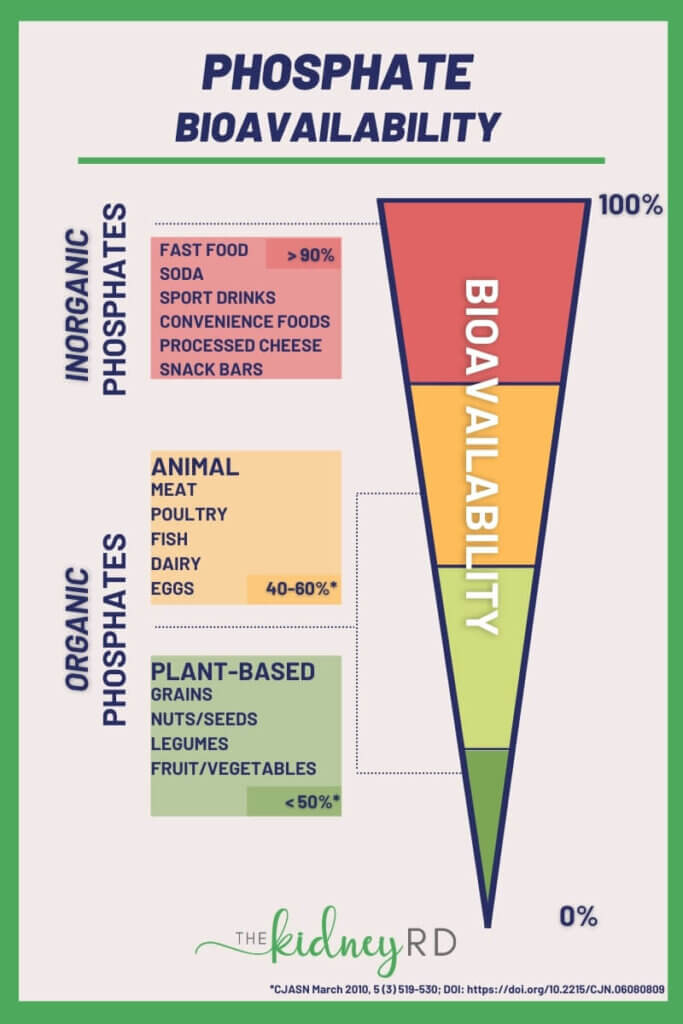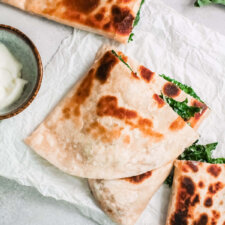This vegan quesadilla is a satisfying plant-based alternative to everyone’s favorite dish. But are you surprised that whole wheat tortillas are included in a kidney-friendly recipe? Have you heard that limiting whole grains in your diet is important to help lower your phosphorus intake? Read on to learn about different phosphorus sources and how each one is absorbed by the body in different amounts. We also added an easy trick to quickly prepare kale for any recipe!

Kale and those pesky stems!
When a recipe says to prepare kale by “removing the tough center rib” do you groan a little inside? Removing the stems can seem an extra unnecessary step that you just don’t have time for! This is often suggested because kale leaves cook much faster than their sturdy stems. In this vegan quesadilla recipe we want a nice soft, chewy filling so removing the stem is ideal.
De-stem with ease!
There are two schools of thought about how to de-stem a kale leaf. The most “civilized” way is to lay your piece of kale on the cutting board and use a paring knife to cut along both sides of the stem. Our preferred method is to grab the end of the stem with one hand and use the other to rip the leaves off its stem. Don’t worry, kale can take it! This is a helpful video that demonstrates both methods. Drop us a comment about your preferred de-stemming method!
Phosphates
Phosphorus plays an important role in bone health as well as nerve and muscle function. When kidney function is normal, excess dietary phosphorus is excreted in the urine. However, when kidney function is compromised, your body has trouble removing the excess phosphorus from the blood. This is why when living with kidney disease, monitoring and limiting your phosphate intake is essential. Understanding the different types of phosphate sources and how your body absorbs them will help you control your phosphate levels.

Organic vs Inorganic Phosphate
Organic phosphates are found in both plant and animal sources. This includes meat, poultry, fish, eggs, dairy, grains, nuts/seeds and beans. Inorganic phosphates are added to many processed or convenience foods to improve shelf life, flavoring and color. Examples of foods with added phosphorus include fast foods, sodas, sports drinks, frozen food, processed cheese and snack bars. Use the nutrition labels to identify added phosphate by looking for the letters “phos” in the ingredient list. Here are some helpful examples to help easily identify added phosphates.
Does your body absorb the same amount of organic and inorganic phosphates?
No! Not all phosphate is absorbed by you body in the same way. Organic phosphates that are plant based have the lowest bioavailable form of phosphate. (Bioavailability is how much of a substance actually enters into your bloodstream.) When you consume legumes or nuts, your body absorbs less than 50% of the phosphate in that food. Animal based sources of organic phosphates have a slightly higher absorption rate, but are still under 60%. Inorganic phosphates have the highest absorption rate of about 90%.
Limiting phosphate ≠ lack of variety in your diet
Phosphorus restriction does not mean a diet with little variety. We recommend reducing the amount of processed foods with inorganic phosphates in your diet and increasing your consumption of food containing plant-based organic phosphates.
Want to learn more about how a plant-based diet can help keep your phosphorus levels in check? A Renal Dietitian can help you understand what amount is right for you! Join our monthly class or schedule a consultation with one of our expert Renal Dietitians to help you on the journey to improving your kidney health.

Creamy Kale Quesadilla
Ingredients
- ½ cup almond milk
- 1 tablespoon all purpose flour
- 1 teaspoon tapioca flour or cornstarch
- 3 tablespoons avocado oil divided
- ½ onion chopped
- 2 cloves garlic minced
- 1 ½ cups kale tough center ribs removed then chopped
- 1 teaspoon nutritional yeast
- ¼ teaspoon smoked paprika
- ¼ teaspoon turmeric
- ¼ teaspoon salt to taste
- ¼ teaspoon pepper to taste
- ⅛ teaspoon cayenne pepper optional
- 2 8- inch whole wheat tortilla
- ½ cup coconut milk yogurt to serve
Instructions
- In a small bowl, add almond milk, all purpose flour, and tapioca flour or cornstarch. Whisk until no lumps remain. Set aside.
- Heat 2 tablespoons of oil in a skillet on medium heat. Add onions and sauté until fragrant and translucent, about 5 minutes. Add garlic and kale; cook until the kale softens, about 3-5 minutes. Add 1 tablespoon of water if the onions start to burn before the kale cooks.
- Once the kale is softened, add nutritional yeast, paprika, turmeric, salt, pepper, and cayenne pepper (optional).
- Take the bowl with almond milk and flour mixture. Whisk once more to make sure no flour lumps remain, then pour mixture into the skillet and stir through the kale. The mixture will thicken quickly. Continue cooking for another minute to fully cook out the raw flour, then remove from the heat.
- On a clean surface, lay out two tortillas. Divide the creamy kale mixture between the tortillas, then fold each tortilla in half.
- In a clean skillet, heat the remaining tablespoon of oil over medium-low heat. Carefully place the folded tortillas into the skillet and cook for about 1-2 minutes each side until golden brown and crispy.
- Slice and serve with coconut milk yogurt on the side.
Notes
Nutrition

KidneyRD Verdict
This vegan quesadilla recipe has become a fast favorite in our household. The texture of the kale and onion mixture is satisfyingly “cheesy” and savory without the dairy. This cheesiness is thanks to the addition of tapioca starch. If it’s hard to find, or you just don’t have it in the cupboard, feel free to swap it out for another thickener. We suggest tapioca because its structure is a little “stringy” once activated. In some recipes, this might not be desirable, but in vegan quesadillas it mimics cheesiness! This guide to thickeners is very useful to understand the simple science behind starches and helpful if you need to swap out one out for another.
ALL information you read on KidneyRD.com is purely for informational and educational purposes. Information is not intended to treat, cure, or prevent any disease.


Pingback: Alkaline Green Power Smoothie - Kidney RD